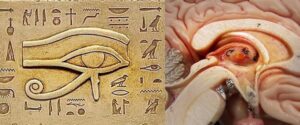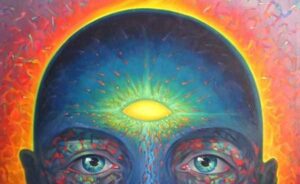The pineal gland – “the third eye” – has gained a mystical significance in spiritual circles. Many believe it is important – few understand what it does.
It weighs about 150 mg and sits in the depression between the superior colliculi at the back of the corpus callosum. The pineal gland is actually not a part of the brain, although it is connected to it [1].
We know that our pineal gland can get calcified [2]. Many believe that a calcified pineal gland can stop us from reaching great spiritual heights.
The jury is still out on that one, but we do know that a calcified pineal gland leads to a defective sense of direction [3]. It has also been implicated in schizophrenia [4]. Increased intake of fluoride might be a significant cause of calcified pineal glands [5], so avoid ingesting large amounts of fluoride.
The pineal gland creates the pineal hormone, called melatonin, out of another spiritually important chemical, serotonin.
The melatonin production and activity in the pineal gland is reduced in response to daylight or artificial bright light. Darkness, on the other hand, activates the pineal gland and stimulates production of melatonin.
 Melatonin has strong sedative [6] effects and is vital in sleeping. An unhealthy pineal gland will result in unhealthy sleep patterns. Melatonin has also been shown to have hypnotic effects [7,8]. If you want to activate your third eye, you need darkness.
Melatonin has strong sedative [6] effects and is vital in sleeping. An unhealthy pineal gland will result in unhealthy sleep patterns. Melatonin has also been shown to have hypnotic effects [7,8]. If you want to activate your third eye, you need darkness.
That is what we know for certain. Try meditating in pitch darkness to create hypnotic effects and access other levels of consciousness. Report your experiences here in the comment section.
Author bio:
Vegard Gjerde is one of the two founders of Global Harmony Crew.
Global Harmony Crew guides people towards deep self-realisation and powerful self-actualisation. Join the crew by subscribing and accelerate your growth and happiness. When you subscribe you get free access to their 20$ course “Master Your Inner Peace – Remain Positive and Unaffected”
Learn more about brain chemistry from their Udemy course.
References:
[1] Siegel, G. J. et al. “Basic Neurochemistry, Molecular, Cellular and Medical Aspects”. Philadelphia, Lippincott-Raven, 1999.
[2] Krsti?, R. “Pineal calcification: its mechanism and significance”. Journal of Neural Transmission, 1986.
[3] Bayliss, C. R., Bishop, N. L., Fowler, R. C. “Pineal gland calcification and defective sense of direction.” British Medical Journal (Clinical Research Ed), 1985.
[4] Sandyk, R., Kay, S. R. “Abnormal EEG and calcification of the pineal gland in schizophrenia”. International Journal of Neuroscience, 1992.
[5] Luke J. “Fluoride deposition in the aged human pineal gland.” Caries Research, 2001.
[6] Johnson, K. et al. “The use of melatonin as an alternative to sedation in uncooperative children undergoing an MRI examination.” Clinical Radiology, 2002.
[7] Tzischinsky O, Lavie P. “Melatonin possesses time-dependent hypnotic effects”. Sleep, 1994.
[8] van den Heuvel, C. J. “Melatonin as a hypnotic”. Sleep Medicine Reviews, 2005.

